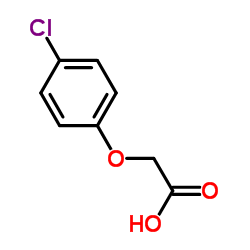4-CPA

4-CPA structure
|
Common Name | 4-CPA | ||
|---|---|---|---|---|
| CAS Number | 122-88-3 | Molecular Weight | 186.592 | |
| Density | 1.4±0.1 g/cm3 | Boiling Point | 315.2±17.0 °C at 760 mmHg | |
| Molecular Formula | C8H7ClO3 | Melting Point | 157-159 °C | |
| MSDS | Chinese USA | Flash Point | 144.4±20.9 °C | |
| Symbol |

GHS07 |
Signal Word | Warning | |
|
Phenoxy herbicides and fibrates potently inhibit the human chemosensory receptor subunit T1R3.
J. Med. Chem. 52 , 6931-5, (2009) We show that phenoxyauxin herbicides and lipid-lowering fibrates inhibit human but not rodent T1R3. T1R3 as a coreceptor in taste cells responds to sweet compounds and amino acids; in endocrine cells of gut and pancreas T1R3 contributes to glucose sensing. Th... |
|
|
Amphiphilic blockers punch through a mutant CLC-0 pore.
J. Gen. Physiol. 133(1) , 59-68, (2009) Intracellularly applied amphiphilic molecules, such as p-chlorophenoxy acetate (CPA) and octanoate, block various pore-open mutants of CLC-0. The voltage-dependent block of a particular pore-open mutant, E166G, was found to be multiphasic. In symmetrical 140 ... |
|
|
Molecular modeling of p-chlorophenoxyacetic acid binding to the CLC-0 channel.
Biochemistry 42(18) , 5176-85, (2003) Molecular simulation techniques were applied to predict the interaction of the CLC-0 Cl(-) channel and the channel-blocking molecule p-chlorophenoxyacetic acid (CPA). A three-dimensional model of the CLC-0 channel was constructed on the basis of the homology ... |
|
|
Chlorophenoxyacetic acid and chloropyridylphenylurea accelerate translocation of photoassimilates to parthenocarpic and seeded fruits of muskmelon (Cucumis melo).
J. Plant Physiol. 168 , 920-926, (2011) We compared the effect of p-chlorophenoxyacetic acid (p-CPA) and 1-(2-chloro-4-pyridyl)-3-phenylurea (CPPU) on parthenocarpic and seeded muskmelon (Cucumis melo) fruits in regards to fruit development and the transport of photoassimilates from leaves exposed ... |
|
|
Chromatographic analysis of 1,3-bis(dimethylamino)isopropyl 4-chlorophenoxyacetate dihydrochloride, a new CNS stimulant.
J. Pharm. Biomed. Anal. 10(2-3) , 213-7, (1992) A reversed-phase liquid chromatographic method is developed for the assay of the new CNS stimulant, 1,3-bis(dimethylamino)isopropyl 4-chlorophenoxyacetate dihydrochloride (BCE-001), and its main contaminant, 4-chlorophenoxyacetic acid (PCPA). In the first pla... |
|
|
Separation of plant hormones from biofertilizer by capillary electrophoresis using a capillary coated dynamically with polycationic polymers.
Anal. Sci. 22(6) , 811-4, (2006) A new, simple and rapid capillary electrophoresis (CE) method, using hexadimethrine bromide (HDB) as electroosmotic flow (EOF) modifier, was developed for the identification and quantitative determination of four plant hormones, including gibberellin A3 (GA3)... |
|
|
Photochemical degradation of pesticides: photocatalytic effect of Fe(III) ions on methylene blue sensitized interaction of 4-chlorophenoxyacetic acid with H2O2.
Bull. Environ. Contam. Toxicol. 49(6) , 834-8, (1992)
|
|
|
Effect of the herbicide 4-CPA on human erythrocyte antioxidant enzymes in vitro.
Redox Rep. 6(3) , 153-4, (2001) To investigate the possible role of oxygen free radicals and oxidant stress in the toxic effects of phenoxyherbicides, we studied the in vitro effect of 4-chlorophenoxyacetic acid (4-CPA) on various human erythrocyte antioxidant enzymes, namely glucose-6-phos... |
|
|
[Synthesis and characterization of complex of NdL3.2H2O].
Guang Pu Xue Yu Guang Pu Fen Xi 20(3) , 322-3, (2000) The binary solid complexes using rare earth ion Nd3+ with the ligand L (L = O-chorophenoxyacetic acid and 3-methoxybenzoic acid) has been synthesized in this work. The chemical formula of the complex was determined to be NdL3.2H2O by elemental analysis. The c... |
|
|
[Synthesis and spectroscopic analysis of complex Eu(o-ClC6H4OCH2COO)3.2,2'-bipy].
Guang Pu Xue Yu Guang Pu Fen Xi 22(1) , 57-8, (2002) This work has synthesized a title complex using rare earth ion Eu3+ with the o-chlorophenoxyacetic acid and 2,2'-bipyridine. The chemical formula of the complex was determined to be Eu(o-ClC6H4OCH2COO)3.2,2'-bipy by elemental analysis, analysis of IR, UV, flu... |